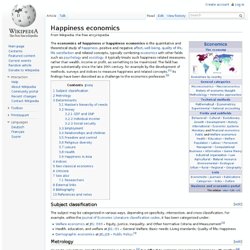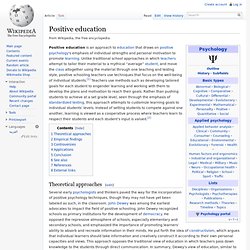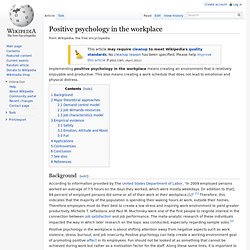

The Science of Procrastination and How to Manage It, Animated. Happiness measurement. Happiness economics. Subject classifications[edit] The subject may be categorized in various ways, depending on specificity, intersection, and cross-classification.

For example, within the Journal of Economic Literature classification codes, it has been categorized under: Welfare economics at JEL: D63 – Equity, Justice, Inequality, and Other Normative Criteria and Measurement[1]Health, education, and welfare at JEL: I31 – General Welfare; Basic needs; Living standards; Quality of life; Happiness[3]Demographic economics at JEL:J18 – Public Policy.[4] Metrology[edit] Given its very nature, reported happiness is subjective.[5] It is difficult to compare one person’s happiness with another's.[1] It can be especially difficult to compare happiness across cultures.[1] However, many happiness economists believe they have solved this comparison problem.
Micro-econometric happiness equations have the standard form: .[1] In this equation is the reported well-being of individual at time. Early "Positive Psychology" Techniques. Physical education. In Education. Positive education. Theoretical approaches[edit] Maria Montessori, the originator of the Montessori system, put forth views relating to positive schooling as well.

The Montessori system is largely based on the positive psychology principle of creativity. Creativity, known as one of the twenty-four character strengths,[4] is offered with the freedom for children to choose how they learn, known as self-directed learning. Children are provided with hands-on materials, which not only inspires creativity, but also stimulates interest in learning, as children are able to express themselves through learning, rather than feeling forced to work in order to learn.[5] Elizabeth Hurlock was one of the first psychologists to actually carry out experiments with positive psychology techniques to measure the effects of positive schooling in the field of education.
Jeniffer Henderlong and Mark Lepper echo Hurlock's arguments that praise is beneficial to enhancing children's intrinsic motivation. Empirical findings[edit] Clinical Psychology. Positive psychology in the workplace. Implementing positive psychology in the workplace means creating an environment that is relatively enjoyable and productive.

This also means creating a work schedule that does not lead to emotional and physical distress. Background[edit] According to information provided by The United States Department of Labor, “In 2009 employed persons worked an average of 7.5 hours on the days they worked, which were mostly weekdays. [In addition to that], 84 percent of employed persons did some or all of their work at their workplace.[1]” [1] Therefore, this indicates that the majority of the population is spending their waking hours at work, outside their homes.
Therefore employers must do their best to create a low stress and inspiring work environment to yield greater productivity. Major theoretical approaches[edit] Martin E.P. Abraham Maslow and Carl Rogers developed Humanistic Psychology that focuses on the positive potential of people and on helping people to reach their full potential.[5] In the workplace. In offender rehabilitation. Other future research.